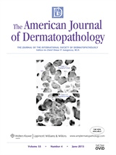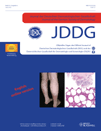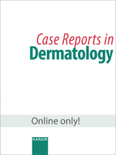
AMERICAN JOURNAL OF DERMATOPATHOLOGY
Scope & Guideline
Empowering Professionals with Essential Dermatopathology Knowledge
Introduction
Aims and Scopes
- Histopathological Analysis of Skin Diseases:
The journal consistently publishes articles that provide detailed histopathological insights into various skin disorders, including neoplasms, inflammatory conditions, and infectious diseases, thereby enhancing understanding and diagnosis. - Clinical Case Reports and Challenges:
A significant portion of the journal's content is dedicated to clinical case reports that present unique or challenging cases in dermatopathology, fostering knowledge sharing and discussion among professionals. - Immunohistochemistry and Molecular Pathology:
Research focusing on the application of immunohistochemical techniques and molecular pathology in diagnosing skin conditions is a core area, highlighting advancements in diagnostic accuracy and treatment approaches. - Emerging Dermatopathological Entities:
The journal addresses new and rare dermatopathological entities, documenting their clinical presentations, histological features, and implications for diagnosis and management, contributing to the evolving landscape of dermatopathology. - Therapeutic and Prognostic Implications:
Research articles often discuss the therapeutic implications of histopathological findings and their prognostic significance in skin cancer and other dermatological conditions, aiding clinicians in treatment planning.
Trending and Emerging
- Integration of Artificial Intelligence in Diagnostics:
Recent publications increasingly focus on the application of artificial intelligence and machine learning techniques in dermatopathology, enhancing diagnostic accuracy and efficiency. - Molecular Pathology and Genomic Studies:
There is a rising trend in studies exploring the molecular and genomic underpinnings of skin diseases, including the use of next-generation sequencing and genetic profiling, which provide insights into disease mechanisms and potential therapeutic targets. - Cutaneous Manifestations of Systemic Conditions:
An emerging area of focus involves the exploration of cutaneous manifestations associated with systemic diseases, highlighting the interconnectedness of dermatology and other medical disciplines. - Innovative Therapeutic Approaches:
The journal has seen an increase in articles discussing novel therapeutic strategies, particularly in the context of immunotherapy and targeted treatments for skin cancers, reflecting advancements in patient management. - Environmental and Infectious Impacts on Dermatology:
There is a growing interest in examining how environmental factors and infectious agents influence dermatopathological conditions, especially in light of recent global health challenges.
Declining or Waning
- Traditional Histopathological Techniques:
There appears to be a gradual decline in publications centered around traditional histopathological techniques without the integration of modern molecular or immunohistochemical methods, reflecting a shift towards more advanced diagnostic approaches. - Rare Infectious Dermatoses:
The frequency of articles focusing specifically on rare infectious skin diseases has diminished, possibly due to the increasing focus on more prevalent or novel dermatopathological conditions. - Historical Perspectives in Dermatopathology:
There has been a noticeable decrease in articles that provide historical reviews or perspectives on dermatopathology, indicating a shift towards contemporary research and emerging findings. - Overlapping Conditions in Dermatopathology:
The exploration of overlapping conditions or differential diagnoses in dermatopathology has become less frequent, suggesting a narrowing of focus towards more distinct entities and clear-cut diagnoses. - General Dermatological Reviews:
General reviews of dermatological conditions that do not delve deeply into histopathological aspects or specific diagnostic challenges have seen a decline, as the journal emphasizes more specialized content.
Similar Journals

JOURNAL DER DEUTSCHEN DERMATOLOGISCHEN GESELLSCHAFT
Empowering knowledge in the field of dermatology.JOURNAL DER DEUTSCHEN DERMATOLOGISCHEN GESELLSCHAFT, published by Wiley, is a prominent periodical in the field of dermatology, recognized by its Q2 quartile ranking in the 2023 dermatology category. With a dedicated focus on advancing knowledge in dermatological science, the journal publishes rigorous peer-reviewed research that encompasses a range of topics including clinical studies, research methodologies, and innovative treatment practices in dermatology. Its impact is reflected in its Scopus ranking, where it stands at #48 out of 142 in the medicine dermatology category, placing it in the top 66th percentile. Although not an Open Access journal, it serves as a critical resource for researchers, clinicians, and students alike, facilitating the dissemination of high-quality research findings and fostering a deeper understanding of dermatological conditions and treatments. With years of convergence from 2003 to 2024, this journal remains a vital platform for scholarly dialogue and discovery in dermatology.

Case Reports in Dermatology
Transforming patient outcomes through shared clinical experiences.Case Reports in Dermatology is a leading Open Access academic journal dedicated to the publication of case reports and unique clinical findings in the field of dermatology. Published by KARGER and based in Switzerland, the journal has been an open access resource since 2009, enhancing the visibility and accessibility of vital research for dermatology professionals and the scientific community. With an impressive ISSN of 1662-6567 and ranking in the Q3 category among dermatological journals, it serves as a crucial platform for researchers seeking to share innovative case studies, validate diagnostic approaches, and explore treatment outcomes. The journal continues to contribute to advancing dermatological science with a convergence timeline extending from 2010 to 2024. By promoting the dissemination of emerging knowledge and practices, Case Reports in Dermatology plays a significant role in fostering collaboration among practitioners, enhancing educational efforts, and ultimately improving patient care in dermatology.

Journal of Dermatology & Dermatologic Surgery-JDDS
Unveiling Breakthroughs in Skin Science and SurgeryJournal of Dermatology & Dermatologic Surgery (JDDS) is a premier open access journal published by Wolters Kluwer Medknow Publications since 2018. This journal serves as a vital platform for the dissemination of cutting-edge research and advancements in the field of dermatology and dermatologic surgery. With its ISSN 2352-2410 and E-ISSN 2352-2429, JDDS strives to present high-quality articles that encompass clinical studies, innovative surgical techniques, and comprehensive reviews, thereby catering to the interests of researchers, medical professionals, and students alike. The journal has gained recognition within the academic community, evidenced by its Scopus ranks, placing it 237th out of 551 in the Medicine - Surgery category and 70th out of 142 in Medicine - Dermatology. The open access model not only enhances visibility but also encourages global collaboration and knowledge sharing in the rapidly evolving field of dermatology. Targeting the needs of diverse audiences, JDDS continues to foster an environment for scholarly communication and contributes significantly to the advancement of dermatologic sciences.

International Journal of Clinical and Experimental Pathology
Unlocking the Secrets of Pathology for AllInternational Journal of Clinical and Experimental Pathology, published by E-CENTURY PUBLISHING CORP, serves as a vital resource for professionals in the field of pathology. With its ISSN 1936-2625, the journal has positioned itself within the competitive landscape of medical journals, achieving commendable rankings in Scopus, particularly in the categories of Pathology and Forensic Medicine (Rank #98/185) and Histology (Rank #38/58). Although its coverage in Scopus has been discontinued, the journal’s past contributions from 2009 to 2017 continue to be a touchstone for researchers interested in advancing their understanding of clinical and experimental pathology. The open-access format ensures accessibility to a wide audience, fostering collaboration and education in this essential medical discipline. By bridging clinical research and experimental findings, this journal plays a crucial role in disseminating knowledge and enhancing practices within pathology, making it an indispensable tool for researchers, professionals, and students alike.

JOURNAL OF THE AMERICAN ACADEMY OF DERMATOLOGY
Empowering skin health through groundbreaking research.JOURNAL OF THE AMERICAN ACADEMY OF DERMATOLOGY, published by Mosby-Elsevier, stands at the forefront of dermatological research and education. With an impressive impact factor and categorized as Q1 in Dermatology, this journal has established itself as a pivotal resource for healthcare professionals and researchers in the field. Since its inception in 1979, it has provided a platform for high-quality peer-reviewed articles, contributing significantly to advancements in dermatological science and practice through 2024. The journal commands an honorable position, ranking #8 out of 142 in the Scopus database's medicine dermatology category, placing it in the 94th percentile among its peers. Readers can access a wealth of cutting-edge studies, case reports, and reviews that address a broad spectrum of topics, from clinical dermatology to emerging therapies. In addition, the journal's commitment to excellence ensures it remains an essential tool for students, clinicians, and researchers dedicated to improving skin health and furthering knowledge in dermatology.

Przeglad Dermatologiczny
Empowering Knowledge in Dermatology Since 1951Przeglad Dermatologiczny is a peer-reviewed open-access journal published by TERMEDIA PUBLISHING HOUSE LTD, based in Poland. Since its establishment in 1951, this journal has been dedicated to advancing the field of dermatology by providing a platform for the dissemination of original research, reviews, and clinical case studies. With an e-ISSN of 2084-9893, it has gained recognition within the academic community, despite its current classification in the Q4 quartile of dermatological journals. The journal has been openly accessible since 2009, promoting wider dissemination of scientific knowledge, and is crucial for researchers, professionals, and students alike. While it holds a current rank of #105 out of 142 in the Scopus Dermatology category, the journal continually strives to enhance its impact through quality publications that address pressing dermatological issues. The diverse range of topics covered in the journal ensures it remains a vital resource for those looking to stay informed on the latest developments in dermatological research.

PATHOLOGY INTERNATIONAL
Elevating Research in Pathology and Forensic MedicinePATHOLOGY INTERNATIONAL, published by WILEY, stands as a distinguished journal in the field of pathology and forensic medicine, serving as an essential resource for researchers, clinicians, and students alike. With its ISSN 1320-5463 and E-ISSN 1440-1827, PATHOLOGY INTERNATIONAL has established itself since its inception in 1951, navigating through an evolving landscape in medical science with insights and breakthroughs up to 2024. It holds a commendable Q2 ranking in both the Medicine (miscellaneous) and Pathology and Forensic Medicine categories, indicating its robust influence and quality within these fields, as evidenced by its placement in the 70th percentile of Scopus rankings. While currently not an open-access journal, it provides access options that ensure valuable research remains available to the academic community. PATHOLOGY INTERNATIONAL commits to advancing the discipline through pioneering research articles, comprehensive reviews, and expert opinions that push the boundaries of understanding in pathology, thereby supporting the enhancement of diagnostic and therapeutic practices.

AMERICAN JOURNAL OF SURGICAL PATHOLOGY
Transforming Understanding in Pathology and SurgeryThe American Journal of Surgical Pathology, published by Lippincott Williams & Wilkins, is a premier peer-reviewed journal serving as a vital resource for pathologists, surgeons, and researchers in the medical field. With an impressive impact factor reflective of its esteemed standing in the academic community, the journal ranks in the Q1 quartile for Anatomy, Pathology and Forensic Medicine, and Surgery as of 2023. The journal's Scopus rankings further highlight its significance, placing it within the top tiers in multiple medical disciplines. Established in 1977 and continuing through 2024, its scope encompasses groundbreaking research, critical reviews, and updates in surgical pathology, making it an essential tool for advancing the scientific community's understanding of disease mechanisms and therapeutic approaches. Researchers, clinicians, and students will find both comprehensive studies and innovative insights, ensuring they remain informed about the latest developments in surgical pathology.

JOURNAL OF DERMATOLOGY
Elevating dermatological knowledge, one study at a time.The Journal of Dermatology, published by Wiley, is a premier academic journal dedicated to advancing the field of dermatology, with its esteemed reputation reflected in its Q1 ranking in Dermatology and a remarkable Q2 ranking in Miscellaneous Medicine as of 2023. Since its inception in 1974, the journal has become a vital resource for researchers, clinicians, and students alike, covering pioneering studies and cutting-edge advancements in skin health and disease. With a Scopus rank of #32 out of 142 in the Dermatology category, placing it in the 77th percentile, the journal underscores its commitment to fostering knowledge and innovation within the dermatological community. Although the journal operates under a subscription model, it remains an essential platform for disseminating impactful research that shapes clinical practice and enhances patient care. For anyone invested in dermatological sciences, Journal of Dermatology serves as a key publication where critical insights and developments are regularly showcased.

Indian Journal of Dermatology Venereology & Leprology
Advancing Knowledge in Skin Health and Infectious DiseasesThe Indian Journal of Dermatology Venereology & Leprology (IJDL) is a premier open-access journal dedicated to the fields of dermatology, venereology, and leprology, published by SCIENTIFIC SCHOLAR LLC since 2004. With a rich historical background dating back to 1976, the journal has established itself as a reputable source for high-quality research and clinical advancements in these disciplines. The IJDL is recognized for its academic rigor, boasting a 2023 category quartile ranking of Q2 in Dermatology and Q3 in Infectious Diseases, indicating its significant contribution to these fields. With an accessible online platform, researchers, practitioners, and students alike can readily explore the latest studies, case reports, and reviews that address key issues affecting public health, particularly in India and beyond. The journal serves not only as a repository of valuable knowledge but also as a vital forum for the exchange of ideas, fostering collaboration and innovation among professionals dedicated to enhancing skin health and combating infectious diseases.